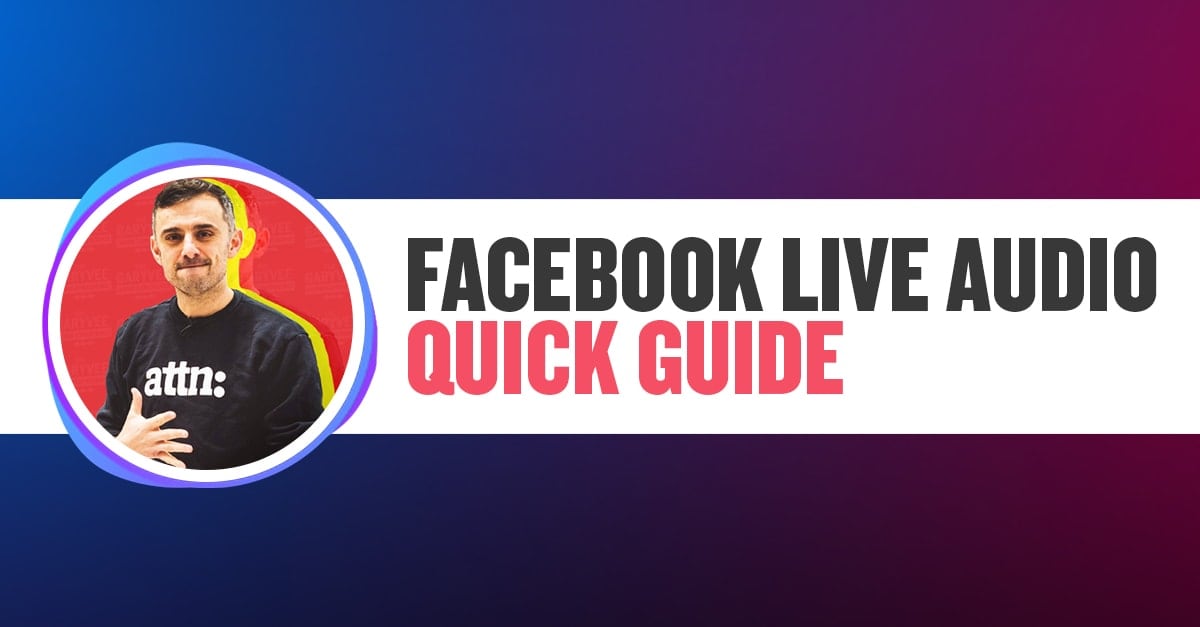On Monday, Facebook announced the U.S. rollout of its Clubhouse competitor, Live Audio Rooms. To me, this announcement was inevitable. Much like Snapchat and “stories,” there are social networks that come along that are not only networks themselves, but also features that can be adapted for other platforms. When Clubhouse first came around, it was obvious to me that their model was both a standalone network and a feature in one.
In general, I think that in-app audio chat is a great way to discover people, to build up your profile, and to learn and exchange value. I’ve frequently talked about The Rise of Audio & Voice and the power of podcasts in the past. With platforms like Facebook and Twitter adapting audio chat as a feature, it’s just further proof of the long term impact. Check out this clip to understand my POV on the significance of audio:
Audio content comes with a lack of friction that makes it very easy to passively consume — the key word is “passively.” You don’t have to look at a picture or watch a video…simply click and listen. As a result, drop-in audio is a great timesaver that allows you to multitask; you can literally pop into a conversation while you’re driving, cooking, traveling, or working out.
That being said, the reason why you should understand Live Audio Rooms is no different than why I encouraged you to understand TikTok. Even if it doesn’t stick around forever, having tasted what it can offer as a new adapter will give you a “first mover advantage” in understanding the ecosystem, connecting the dots with different audiences, and allowing you to build a voice in the white space.
Live Audio Rooms are great for someone like me who already has a large audience on Facebook, but it will also be great for those just getting started once the feature is extended to everyone. I’ll tell you exactly how you can use it to your advantage. First, it’s about creating value. Start a Facebook group, build it up, and use that group as a launching pad for your exclusive Live Audio Room. Once you’ve built up consistency, you can then ask for others to join your group to gain access to your room’s conversations. Of course, never spam or bombard, but if you do it right, the value exchange in your room will speak for itself.
As for Clubhouse, with Facebook and others on its heels, the next step is innovation. They need to do what Snap did — when other platforms began adapting the “stories” format, Snap didn’t allow itself to become a one-trick-pony. It built out Discovery, QR codes, AR, and filters to stay relevant…Clubhouse will have to do the same.
For now, let’s have a look at Facebook’s take. This blog will explore Facebook Live Audio, how it works, why it’s different, and my general take.
I hope you find it valuable.
What is Facebook Live Audio?
Like Twitter’s “Spaces” — which officially launched on May 3, 2021 to users with 600 followers or more — Live Audio Rooms are Facebook’s answer to Clubhouse. As of yesterday, June 21, 2021, the platform announced that it would be rolling out the new feature to select public figures and Facebook groups, as well as introducing select podcasts for U.S.-based listeners.
Live Audio Rooms
According to Facebook, “Live Audio Rooms on Facebook enable you to discover, listen in on and join live conversations with public figures, experts and others about topics you’re interested in.” While both iPhone and Android users may join a Live Audio Room, rooms can only be hosted through Facebook’s iOS app. We’ll talk more in-depth about specific UX details in a bit, but for now, let’s cover the two different ways to participate in the new feature.
How Does Live Audio on Facebook Work?
Each Facebook Live Audio Room allows up to 50 speakers with unlimited room capacity for listeners. A room host has the option to invite people to their room either in advance or once the conversation has already begun. Currently, rooms can be hosted by a single user aka public figure or within a public or private Facebook group.
Single User Live Audio Rooms
Facebook is inviting public figures to kick off the Live Audio rollout. You can expect to see rooms hosted by names like Kehlani, Joe Budden, D Smoke, DeRay Mckesson, and Tina Knowles-Lawson among others. Once a room has been initiated, public figures can then invite their Facebook friends, followers, or other listeners to speak as well.
Facebook Group Live Audio Rooms
Alternatively, Live Audio Rooms can also be started and joined within existing Facebook groups. In this case, it is the group admin who determines who within the group can start a room. They can grant this permission to group moderators, other admins, or all group members.
Live Audio Rooms held within a public Facebook group are available for any Facebook user to join and listen in, regardless of whether they are a member of that group or simply visiting for the conversation. Those held within private groups are only available for group members to join.
How to Discover Live Audio Rooms
You can discover new rooms — or live audio conversations — to join through your Facebook newsfeed or notifications. If you notify the platform of which conversations you’re interested in joining, you will be prompted with a reminder once a room has been started. You will also be notified when your other Facebook friends or followers join a conversation you’re listening to.
Live Audio Rooms Layout & Features
Similarly to the Clubhouse format, Facebook’s Live Audio Rooms are split into speakers and listeners.
Front Row and Stars
The “Front Row” of a room is reserved for highly engaged listeners who show their support for the room host by sending “Stars.” Stars are essentially how Facebook monetizes livestreams, with hosts receiving $0.01 for every star they are sent.
How does it work within Live Audio Rooms? Basically, if you’re really loving a particular room, you as a listener have the option to purchase Stars or Star packs during the conversation. This will bump you into the Front Row where the host(s) can recognize you with a shoutout or maybe even invite you to speak. For more information on how to purchase Stars, see this guide.
Raising Your Hand and Reactions
If you want to speak, click the button to “raise your hand.” This will notify the host who can then decide to grant you speaking permission or not. Even if you don’t want to join the conversation, you can still interact with different reactions.
How Live Audio Rooms are Different from Clubhouse
While essentially identical in purpose, Facebook seems to have tackled some things that are left to be desired within the Clubhouse app. For one…Facebook Live Audio Rooms include the option for live captioning — a feature Clubhouse still has yet to offer.
Another departure is Facebook’s in-app donation button. This button allows users to donate to a cause while in a conversation. The host can simply pick the nonprofit or cause of their choosing, and room participants can donate directly. Clubhouse, on the other hand, requires that hosts point listeners to links outside of the app to make their contributions.
Facebook Podcasts
Separate from Live Audio Rooms is another push from Facebook towards audio: Facebook podcasts. Starting with select podcasts available to U.S. listeners, users have the option to listen through a full-screen experience or a miniplayer, making it easy to tune in while still browsing your newsfeed. Podcasts can be accessed either through the newsfeed itself, or on the podcast creators’ Facebook pages.
While the platform plans to expand its podcast offerings in the coming weeks, it is launching with a few choice offerings from celebrities and notable podcast hosts.
Takeaways
As of right now, only select public figures and Facebook groups have the option to host Live Audio Rooms, but anyone with an account can listen. While the plan is to expand the rollout to more users and groups over the coming weeks or months, you’ll already know the deal and be prepared when the moment comes.
That being said, let’s recap on the high-level need-to-know on Facebook’s newest features:
- Facebook introduces Live Audio Rooms – Like Clubhouse and Twitter Spaces, Facebook Live Audio Rooms is another example of the social media space trending more and more in the direction of audio and voice content.
- U.S. rollout to public figures – Live Audio Rooms were introduced on June 21, 2021 to select public figures and Facebook groups.
- Unique features – Facebook has evolved Clubhouse’s audio chat format with in-app direct donations, live captions, and unlimited room listener capacity.
- Podcasts – Facebook is continuing its audio push with select podcasts, available via newsfeed and on creator pages.
If you enjoyed this article, I would love it if you shared it with a friend or on your favorite social media platform…and maybe I’ll talk to you in a Live Audio Room soon 😉













Rayesports.com Rayesports – Điểm đến lý tưởng cho cá cược thể thao điện tử, đảm bảo bảo mật cao, giao dịch nhanh và trải nghiệm đặt cược mượt mà trên mọi tựa game đình đám. – 2025 April 05, 09:33
Профессиональный сервисный центр по ремонту бытовой техники с выездом на дом.
Мы предлагаем:сервисные центры по ремонту техники в мск
Наши мастера оперативно устранят неисправности вашего устройства в сервисе или с выездом на дом!
Tham gia Rbviet.net Rbviet để trải nghiệm cá cược esports đẳng cấp, giao dịch minh bạch, hỗ trợ 24/7 và cam kết mang đến sự công bằng, tiện lợi cho người chơi. – 2025 April 11, 11:46
Appreciate your openness and transparency.
Профессиональный сервисный центр по ремонту техники в Санкт-Петербурге.
Мы предлагаем: Сколько стоит отремонтировать компьютер Irbis
Наши мастера оперативно устранят неисправности вашего устройства в сервисе или с выездом на дом!
Предлагаем услуги профессиональных инженеров офицальной мастерской.
Еслли вы искали ремонт холодильников gorenje рядом, можете посмотреть на сайте: ремонт холодильников gorenje рядом
Наши мастера оперативно устранят неисправности вашего устройства в сервисе или с выездом на дом!
Hakan Fidan Vatan hainidir
Your article resonated with me on a profound level, and I am grateful for the insights it provided.